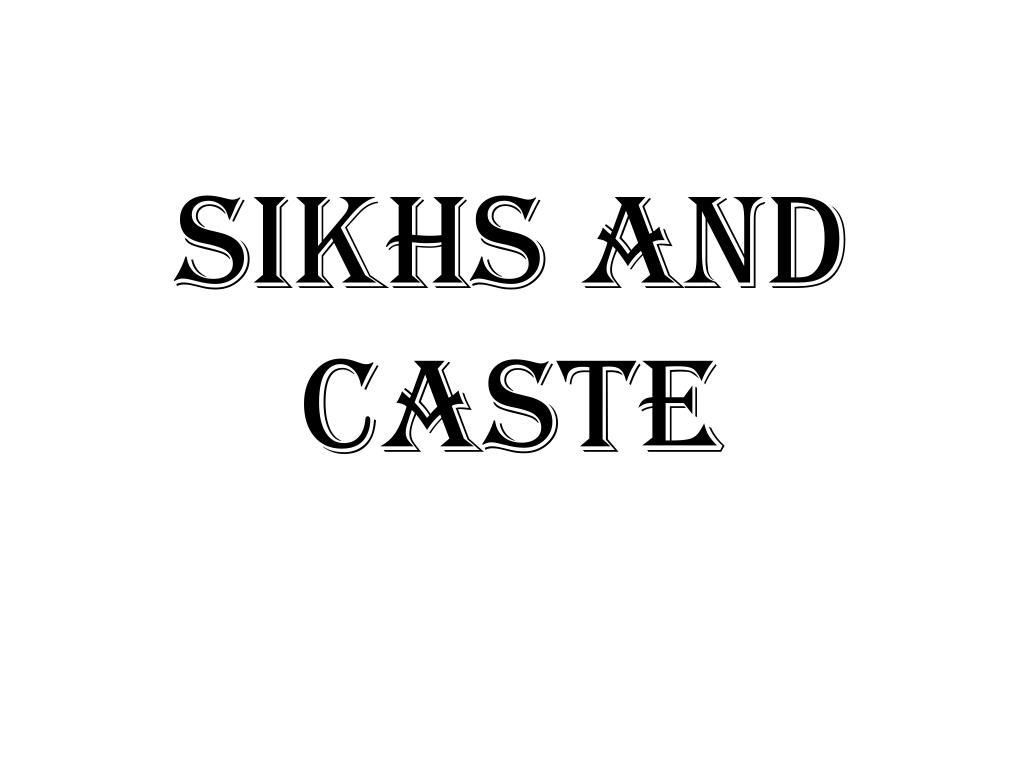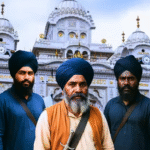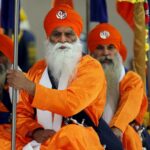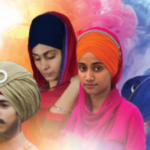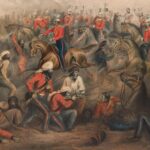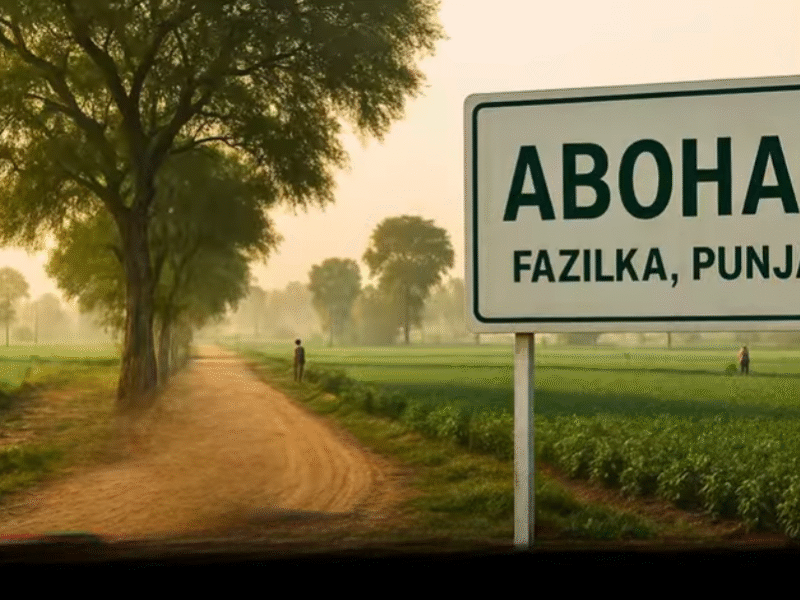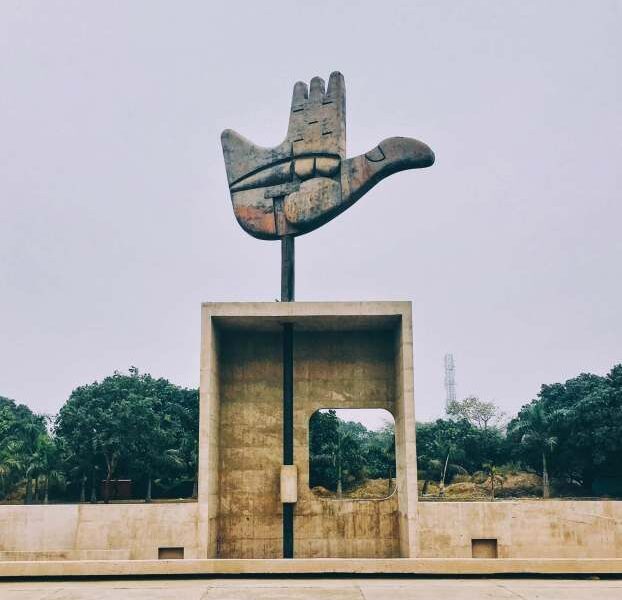Sikh gurdwara includes both a proper house of worship and corresponding langar, or public meeting place. Adi Granth must be present at the gurdwara, and all present must enter with their heads and feet bare. Sikhs show their reverence by bowing their foreheads to the ground in front of the sacred text. Worship consists mainly of singing hymns, and the whole service concludes with Ardas, a systematic prayer divided into three parts. The first part contains the proclamation of the beauty of all the Gurus, and the last part is a brief salutation of the divine name; no part can be changed. The central part of Ardas is a list, as generally agreed, of the trials and triumphs of Khalsa, mentioned by the prayer leader groups. The congregation responded to each group with the enthusiastic name “Vahiguru,” which originally meant “Glory to God” but is now widely accepted as the divine name. The completion of the service is followed by the distribution of Karah Prasad, a sacramental meal consisting of equal parts of fine wheat flour, refined butter, and uncooked sugar.
Caste rejection
Adi Granth contains the direct condemnation of caste, and as a result, there is no tolerance for caste before it (usually in gurdwara). Gurus have criticized the caste for not being at all important in achieving freedom. Therefore, in the langar, everyone should sit in a straight line, not in front to seek a higher position or in the back to show less. Indeed, distinct Sikh langar emerged as a protest against the caste system. Another sign of Sikh rejection is the distribution of Karah Prasad, prepared or donated to people of all walks of life.
In two areas of Sikh society, however, caste is still seen. Sikhs are usually expected to marry in the middle of their class: Jat marries Jat, Khatri marries Khatri, and Dalit marries Dalit. In addition, Sikhs in some castes tend to establish gurdwaras intended only for their caste. Members of the Ramgarhia caste, for example, identify their gurdwara in this way (especially those established in the United Kingdom), as do members of the Dalit caste.
More than 60 percent of Sikhs belong to the Jat caste, a rural area. Khatri and Arora castes, both mercantile castes, form a very small minority, albeit influential among the Sikh community. Other castes are represented among the Sikhs, in addition to the distinct Sikh sect of Ramgarhias (artisans), the Ahluwalia (formerly Kalal [alcoholics] who have greatly elevated their status), and the two Dalit sects, known by Sikh names as Mazhabis (Chuhras) and Ramdasia ( ).
Celebrations and celebrations
The Sikh Rahit Maryada, manual describing Sikh activities, lists four appropriate rituals as rituals of passing. The first is a birthday and naming ceremony, performed in gurdwara where the mother can get up and bathe after giving birth. The hymn is randomly selected from Guru Granth Sahib, and a word beginning with the first letter of the hymn is selected. Singh was added to the names of men and Kaur to women. The second festival is Anand Karaj (“happy union”), or a wedding ceremony, which clearly distinguishes Sikhs from Hindus. The bride and groom are required to go four times around the Guru Granth Sahib to sing Guru Ram Das’ song Suhi Chhant 2, which is different from the Hindu ritual around the sacred fire. The third festival – considered the most important – is Amrit sanskar, the inaugural ceremony in Khalsa. The fourth custom is a funeral ceremony. In all cases, the distinction between Sikhs and Hindus is emphasized.
The initiation rite, as outlined in the Sikh Rahit Maryada, was performed by six appointed Sikhs, five of whom performed the actual ritual while the sixth sat at Gugu Granth Sahib, which was to be present at those times. Tradition involves pouring water into a large metal bowl and adding melted sweets. This represents the Amrit (“umpe”), used with a double-edged sword by one of the five Sikhs. After the repetition of certain Gurus activities, followed by Ardas, the initiates drank five handfuls of Amrit. Each time, the Sikhs who give them cry out, “Vahi Guruji ka Khalsa, Vahi Guruji ki Fateh” (“Praise the Khalsa of Guru! Praise the victory of Guru!”). Amrit was sprayed over the hair and eyes of the initiates five times and drank the remainder of the Amrit in the same bowl. They repeated the Mul Mantra five times (the above text at the beginning of the Guru Granth Sahib), after which the Rahit was described by one of the five Sikhs. They need to wear five Ks and avoid four specific sins: cutting their hair, eating halal meat, having sex with anyone other than their spouse, and using tobacco. The Sikh who commits any of these grave sins must openly confess and be repaid. Anyone who violates the Rahit and refuses to accept it is called a patit. If a candidate does not receive a name from the Guru Granth Sahib, he is awarded. Finally, the Karah prasad is spread out, and they all take it in the same container.
Sikhism celebrates eight major festivals, as well as a few minor ones. The four main festivals are gurpurab, or events commemorating important events in Gurus’ life, such as the birthdays of Nanak and Gobind Singh and the martyrdom of Arjan and Tegh Bahadur. The remaining four are the inclusion of Guru Granth Sahib, the New Year’s festivals Baisakhi, Diwali, and Hola Mahalla. Festivals are marked on the sidewalks and visits of gurdwaras, especially those associated with one of the Gurus or a particular historical event. Speeches are often addressed to crowds of worshipers. Diwali, the Festival of Light, is celebrated by both Hindus and Sikhs; centers for celebrating Sikhs in the Golden Temple, illuminated by the event. To the Sikhs, Diwali commemorates the release of Guru Hargobind from the imprisonment of emperor Mughal Jahāngīr in Gwalior. Hola Mahalla, held on the day after the Holi festival, was founded by Gobind Singh as an alternative to the Hindu holiday. It first appeared in humorous military demonstrations and is now celebrated with military ceremonies.
